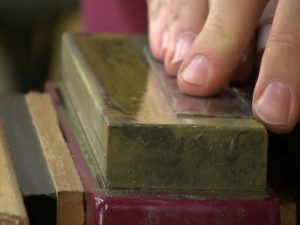 Card scrapers are great tools for surface prep, but there’s a bit of a learning curve. Many woodworkers often do more damage with a card scraper than good. The keys to getting great results are in an adequately sharpened edge and employing the correct technique when scraping.
Card scrapers are great tools for surface prep, but there’s a bit of a learning curve. Many woodworkers often do more damage with a card scraper than good. The keys to getting great results are in an adequately sharpened edge and employing the correct technique when scraping.
Neither the sharpening nor the technique is a hard skill to master, but like most things woodworking, they take a bit of practice. In the video, I break down both skills so you can get your card scrapers tuned up and working at peak efficiency.
Sharpening Card Scrapers
 Conceptually, card scrapers are pretty easy to grasp – a piece of hardened steel with the edge mashed over to form a burr. Like most woodworking skills, getting there is half the fun.
Conceptually, card scrapers are pretty easy to grasp – a piece of hardened steel with the edge mashed over to form a burr. Like most woodworking skills, getting there is half the fun.
You want to start with the edge of the scraper properly jointed (filed flat, straight and relatively square). Once jointed I hone the edge and both faces to #4000-grit to produce fairly scratch-free surfaces for creating burrs.
Honing the edge of a blank of steel to that level of refinement before using a harder piece of steel to mash over the edge might seem a bit pointless, but I find it effective. My scrapers regularly pull wider, thicker shavings while leaving a smoother surface. Whenever I’ve tried honing to a lower grit, I don’t seem to get the same results.
 Turning the burr is done with a burnishing tool. I use a triangular burnisher, but round works just as well. The idea is to concentrate the force you exert a one spot on the burnisher in order to push the edge of the scraper over to form the burr.
Turning the burr is done with a burnishing tool. I use a triangular burnisher, but round works just as well. The idea is to concentrate the force you exert a one spot on the burnisher in order to push the edge of the scraper over to form the burr.
By running the burnisher over the edge of the card scraper at an angle, the burr is easily turned. I exert a fair amount of downward pressure when turning the burr. Some find a drop or two of oil helpful when turning a burr, but I can’t feel the interaction between burnisher and scraper as well. I don’t use oil.
Give the video a quick watch and let me know what you think of the method I use. Do you do anything differently?
Do you touch up the scraper with the burnisher occasionally between times jointing it or do you joint it and run it over the stones every time before burnishing?
I don’t touch up with the burnisher in between. I’ve always felt that once the edge is turned the metal won’t hold up on additional burnishings. Besides, a fresh edge leaves the best surface in my experience.
Chuck,
Thanks for this.
I’d like a primer on sharpening a Stanly 80 type scraper if you ever find the time.
I’m hoping to attend one of your classes in the future.
Would you ever consider doing the Walker tea table (at MESDA: https://mesda.org/item/collections/tea-table/2142/). I know it’s ambitious but if we just covered one of the repeating carvings that would be enough to finish at our home shops. I love that piece…..
Thanks!
–Bill